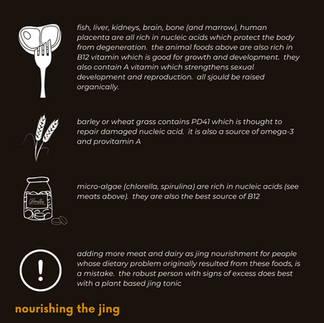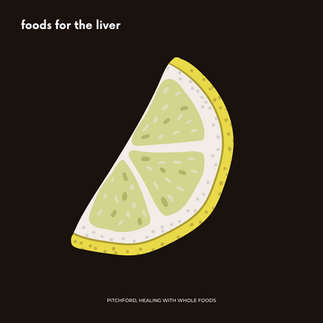
This blog today is going to examine the principles of Chinese medicine nutrition; a practice of healing using natural foods and a central pillar of acupuncture or Chinese medicine treatment.
I use the analogy of the three-legged stool as acupuncture will help you, but often times fundamental changes to the other two legs, food and lifestyle, will enhance clinical results.
I am not a registered dietician. These principles are suggestions based on a Chinese medicine diagnosis and are used to enhance your treatment. For example, if you come in with period pains and we diagnose it is caused by "cold in the uterus" a Chinese medicine diagnosis we would advise that the following amendments should be made between treatments:
Avoidance of raw or cold foods
Avoidance of iced drinks
Avoidance of sitting on cold floors or submerging in cold water
Adding warming foods to your daily meals. This can be the nature of the food i.e. eating only cooked foods, or adding warming spices
For dietary advice please look for people who are registered with a regulatory body such as Tai Ibitoye
I hope you enjoy today's blog and if you have any questions at all please do not hesitate to send me a message, or add a comment below.
Love from Andrea
The history of Chinese medicine nutrition
The application of Chinese medicine nutrition has been noted as far back as 1000 BC with medicinal wine.

Recipes Worth a Thousand Gold, written by Sun Simiao in 654 AD contains the first recorded use of the term “food therapy,” and he hoped that people would first choose food over drugs when suffering from an ailment. Cardamom was noted in Recipes Worth a Thousand Gold to “cure heartburn and stomach ache, stop vomiting, and get rid of bad breath".
Scientists after the 1950s illuminated the active ingredients in cardamom oil, which were found to contain antioxidant, antispasmodic, anti-ulcer, and hepatic effects.
General suggestions of Chinese medicine nutrition

eat with joy to allow your body to accept the food more effectively
eat lovingly and welcome the food wholeheartedly
make mealtime a relaxed occasion and avoid working, watching TV
listen to your body - is it a craving for something. what is that telling you?
chew your food well ~ this lessens the work for the stomach and also warms chilled food
stop before you are full ~ overeating causes stagnation
eat your main meal early ~ eating late causes stagnation
choose (where possible) locally grown food and organic quality food ~ it preserves the life force more
try not to microwave which reduces the life force of food
do not drink too much with your meal - teacup at most. the spleen doesn't like to be wet
don't eat too much raw, chilled food which puts out the digestive fire
Specifics of Chinese medicine nutrition therapy
There are four principles of traditional Chinese medicine food therapy
Eating according to your specific signs and symptoms
Eating according to your body constitution
Eating according to the seasons
Eating according to your environment
Like the example above with the "cold in the uterus" diagnosis and the amendments to food and lifestyle, you should eat and live according to your specific signs and symptoms. If you are a subjectively hot person with a dry cough then you should eat foods that will cool and moisten you. You wouldn't want to be eating a very spicy pizza that is both hot in nature and drying. Instead, you might want to consider a banana that is both cooling in thermal nature and moistening.
But a banana is absolutely no use to you if you are subjectively cold. It will only increase the cold and exacerbate your symptoms.
This is the Yin and Yang of Chinese medicine food therapy. What might be suitable for one person, may not be suitable for another.
Below we are going to examine four food energetics:
Thermal nature
Food flavours
Qi movement
Yin and yang organs
Thermal flavour
All foods in Chinese medicine food therapy are given a thermal flavour rating. For example, chilli is hot, beef is warming, potato is neutral, cucumber is cool and watermelon is cold.
Hot foods
Hot foods are Yang in nature. They speed up Qi, warm, eliminate internal and external cold.
Warm foods
Warm foods strengthen the Yang & Qi and the middle jiao (or Spleen and Stomach)
Neutral foods
Balance the body and builds Qi and Body Fluids
Cool foods
Supplements Blood and Body Fluids and cools the heat
Cold foods
Cool internal heat and calm the spirit
Five flavours

There are five flavours that correspond to the organs in Chinese medicine. These foods also correspond to the seasons.

Bitter foods
Bitter foods relate to the Fire element (Heart, Small Intestine, Pericardium and San Jiao). They also correspond to Summer. They are considered good for drying and down bearing, so useful for digestive and excretion functions

Sweet foods
The sweet taste relates to the Earth element (Spleen and Stomach). The sweet taste strengthens and harmonises, relaxes and moistens. It also corresponds to the season of Late Summer.

Pungent foods
Pungent foods are related to the Metal element (Lung and Large Intestine). The pungent taste is moving and dispersing. This relates to Autumn.

Salty foods
Salty foods correspond to the Water element (Kidneys and Bladder) and Winter. This flavour is considered to be moistening, loosening, cooling and softening.

Sour foods
These foods relate to the Wood element (Liver and Gall Bladder) and Spring. This taste is astringent and gathering and particularly good for nourishing yin fluids and organising scattered mental patterns.
It is interesting to see, for example, that tomato can be sour and cooling or coffee can be bitter and warm. It is important to understand a foods flavour and thermal nature when prescribing certain foods to people and their individual signs and symptoms.
Cooking methods
The method of cooking also impacts the temperature of food. From raw, as the most cooling, to BBQ which is the most heating and drying.
According to your Chinese medicine diagnosis, it would be important to consider which cooking method is most sensible for you. This also applies to the environment in which you live. If you live in the Antarctic it would be unwise to eat sushi for all your meals.

Steaming: provides no change in food energetics.
Boiling: similarly provides no change in food energetics but if you do not use the liquid then nutrients will be lost and it would be considered cooling in nature.
Baking: supplies Yang energy and moderate heat. Useful for baking fruits and vegetables but dry baked goods will consume Yin.
Deep-fried: supplies Yang energy and heat. Can create damp heat that affects the Liver and skin.
Qi movement
Food can direct Qi in our body. If you imagine alcohol, such as whiskey, then when you drink it you might find the Qi rising with a heat travelling from your stomach and seen in redness in the face.

Up: sweet-pungent flavours or warm-neutral thermal temperatures, this is particularly useful in the Spring.
Down: laxative effect with strong salty or bitter flavour and cooling-cold thermal temperature.
Inwards: primarily sour, partly bitter and salty flavour with a cooling-neutral thermal temperature. Retains Qi and Body Fluids on the inside.
Outwards: sweet and pungent with a warm-hot thermal nature which is useful for expelling colds
Foods according to the Chinese medicine organs
As we have seen above, each of the organs is assigned a flavour. However there are lots of foods which can help or hinder and below is a general guide.
The Kidneys
General rules regarding the Kidneys are:
dark foods with a salty flavour, such as black beans cooked with a little seaweed
black sesame seeds
black soybeans
black or dark colours in clothing or food nourish the kidneys
The Heart
Foods for calming the Mind are:
oyster shell
mulberries and lemon
whole wheat, brown rice and oats
dill and basil
reishi mushroom
chamomile

The Liver
The Liver is responsible for the smooth flow of Qi through the body to all organs and in all directions. When this role is impeded it can result in a multitude of physical and emotional symptoms including
impatience
anger
resentment
impulsive
depression
bloating
floaters in the eyes
neck tension
tinnitus
To get the full understanding of these tiles I highly recommend getting a copy of Healing with Whole Foods but I have added below some of the Liver patterns he mentions and the appropriate foods for each.
Liver Qi Stagnation: reduce, stimulate, harmonise, bitter and sour, detox, accelerate
Liver Heat: reduce, harmonise, bitter and sour, detox, accelerate
Deficient Liver Blood and Yin: reduce, harmonise, yin & blood, accelerate
Liver Wind: reduce, detox, liver-wind, accelerate
The Lungs
I would like to do a separate blog on foods for external pathogens i.e. cold and flu, so I will update this at a later time.
These patterns below and their corresponding foods are for interior conditions.
The Spleen
The Earth element, the Spleen and Stomach is the most fundamental of all the organs when it comes to food. It is the element which receives all the food, responsible for digestion and the distribution of foods and nutrients. It is also the element that extracts Qi from the foods, to be used by the body for warmth, immunity, vitality, formation of tissues and mental functions.
So, what does the sum of all this mean?
When you come to visit me for an acupuncture appointment, depending on your Chinese medicine diagnosis I will suggest foods, based on Chinese food therapy principles to take away with you and enhance your treatment.
"dietary therapy should be the first step when one treats a disease. only when this is unsuccessful should one try medicine"
Sun Si Mao
Below is an example of a recipe card, which I have created, for nourishing Yin, if your diagnosis is Yin deficiency. I will give you one of these at the end of your appointment and we will discuss who changes you can feasibly make.

Sources
Five Seasons TCM: https://www.instagram.com/fiveseasonstcm/?hl=en
Yellow Empress Diet TCM: https://www.instagram.com/yellowempressdiet_tcm/?hl=en
The Eastern Philosophy: https://www.instagram.com/theeasternphilosophy/?hl=en































































